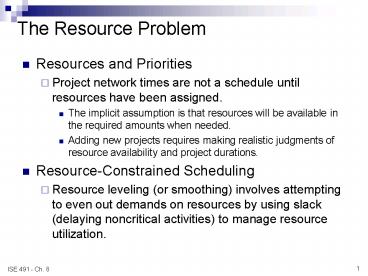The Resource Problem - PowerPoint PPT Presentation
Title:
The Resource Problem
Description:
Example: Botanical Garden project Resource: backhoe costs associated with use competition for the resource FIGURE 8.3 Botanical Garden (cont d) ... – PowerPoint PPT presentation
Number of Views:85
Avg rating:3.0/5.0
Title: The Resource Problem
1
The Resource Problem
- Resources and Priorities
- Project network times are not a schedule until
resources have been assigned. - The implicit assumption is that resources will be
available in the required amounts when needed. - Adding new projects requires making realistic
judgments of resource availability and project
durations. - Resource-Constrained Scheduling
- Resource leveling (or smoothing) involves
attempting to even out demands on resources by
using slack (delaying noncritical activities) to
manage resource utilization.
2
Types of Project Constraints
- Technical or Logic Constraints
- Constraints related to the networked sequence in
which project activities must occur - Resource Constraints
- The absence, shortage, or unique
interrelationship and interaction characteristics
of resources that require a particular sequencing
of project activities
3
Constraint Examples
FIGURE 8.2
4
A third constraint Physical
5
Kinds of resource constraints
- People
- skills, availability, priorities
- Materials
- availability, delivery schedule
- Equipment
- capability, availability, scheduling
- Working Capital
- availability, reliability, timing
6
Classification of a scheduling problem
- Classification of Problem
- Using a priority matrix will help determine if
the project is time or resource constrained - Time Constrained Project
- A project that must be completed by an imposed
date - Time is fixed, resources are flexible additional
resources are required to ensure project meets
schedule. - Resource Constrained Project
- A project in which the level of resources
available cannot be exceeded - Resources are fixed, time is flexible inadequate
resources will delay the project.
7
Resource allocation methods
- Limiting Assumptions
- Splitting activities is not allowedonce an
activity is start, it is carried to completion. - Level of resource used for an activity cannot be
changed. - Activities with the most slack pose the least
risk. - Reduction of flexibility does not increase risk.
- The nature of an activity (easy, complex) doesnt
increase risk.
8
Resource allocation methods (contd)
- Time-Constrained Projects
- Projects that must be completed by an imposed
date - Require the use of leveling techniques that focus
on balancing or smoothing resource demands by
using positive slack (delaying noncritical
activities) to manage resource utilization over
the duration of the project - Peak resource demands are reduced.
- Resources over the life of the project are
reduced. - Fluctuation in resource demand is minimized.
9
Example Botanical Garden project
- Resource backhoe
- costs associated with use
- competition for the resource
FIGURE 8.3
10
Botanical Garden (contd)
FIGURE 8.3 (contd)
11
Resource allocation methods (contd)
- Resource demand leveling techniques for
time-constrained projects - Advantages
- Peak resource demands are reduced.
- Resources over the life of the project are
reduced. - Fluctuation in resource demand is minimized.
- Disadvantages
- Loss of flexibility that occurs from reducing
slack - Increases in the criticality of all activities
12
Resource allocation methods (contd)
- Resource-constrained projects
- Projects that involve resources that are limited
in quantity or by their availability - Scheduling of activities requires the use of
heuristics (rules-of-thumb) that focus on - Minimum slack
- Smallest (least) duration
- Lowest activity identification number
- The parallel method is used to apply heuristics.
- An iterative process that starts at the first
time period of the project and schedules
period-by-period any activities scheduled to
start using the three priority rules
13
Example Resource-constrained schedule
- Resource constraint 3 programmers
FIGURE 8.4
14
Resource-constrained schedule
- Resource load chart (no constraints showing)
ES resource load chart
FIGURE 8.4 (contd)
15
Resource-constrained schedule (cont.)
- Going from period to period, schedule activities
according to the rules (see pg. 241)
Resource-constrained schedule through period 23
FIGURE 8.4 (contd)
16
Resource-constrained schedule (cont.)
Resource-constrained schedule through period 56
FIGURE 8.5
17
Resource-constrained schedule (cont.)
- Final schedule shows delay in project completion
and loss of flexibility
Final resource-constrained schedule
FIGURE 8.5 (contd)
18
Resource-constrained schedule (cont.)
New, resource-constrained network
FIGURE 8.5 (contd)













![[Slide stating problem] PowerPoint PPT Presentation](https://s3.amazonaws.com/images.powershow.com/8278785.th0.jpg?_=20161127064)

















